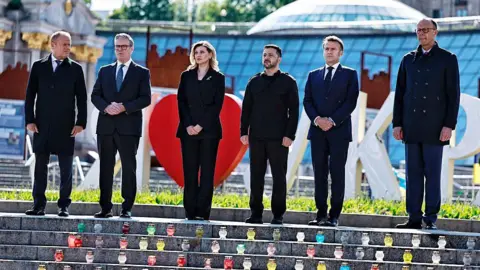Putin Under Pressure: Europe Calls for Ukraine Ceasefire Amid Escalating Tensions
In May 2025, international focus has shifted to Russian President Vladimir Putin as Europe’s leaders step up their demands for peace in Ukraine. Their call for an unconditional ceasefire seeks not only to halt ongoing violence but also to unveil the true intentions behind Putin’s military campaign. This article examines the latest developments, the diplomatic maneuvers shaping the conflict, and what may come next for all parties involved.

Europe’s Unyielding Ceasefire Demand
On May 10, European leaders, including those from France, the United Kingdom, Germany, and Poland, convened in Kyiv with Ukrainian President Volodymyr Zelensky. In a powerful display of unity, they demanded a 30-day unconditional ceasefire from Russia, beginning Monday. The coalition hopes that this proposal will not only pause the fighting but also put Putin’s real goals under an international spotlight.
UK Prime Minister Keir Starmer was direct in challenging the Kremlin: “All of us here together with the US are calling [Russian President Vladimir] Putin out. If he is serious about peace, then he has a chance to show it.” (BBC News).
The United States, represented through recent conversations with President Trump, is also backing this ceasefire plan. European leaders have warned that failure to comply could lead to “massive” new sanctions by both Europe and the US.
Putin’s Dilemma: Accept or Escalate?
For Putin, the European ceasefire proposal presents a challenging decision. Accepting may be seen as a retreat or admission that Russia’s war goals are not being met. Alternatively, rejection (or manipulation) of the offer could escalate tensions and further isolate Russia on the global stage. The Kremlin’s ambiguous response—neither a clear acceptance nor outright denial—reflects the pressure mounting on Putin from both within and outside Russia (CNN).
According to diplomatic sources, if the ceasefire fails, evidence of Russian infractions could spur Europe and the US to impose even harsher economic restrictions. Ukraine, meanwhile, risks losing territory or strategic advantage if the truce is violated and not robustly enforced.
Continued Violence Despite a Pause
Despite recent calls for a temporary ceasefire to mark Russia’s Victory Day, violence persists across Ukraine. Both sides report ongoing attacks and civilian casualties, with accusations of ceasefire breaches being exchanged regularly. In areas like Sumy, Donetsk, and Kherson, Ukrainian sources detail continuing Russian assaults, challenging the credibility of Putin’s commitment to even a short-term stop in fighting (BBC).
The International Stakes and Next Steps
Europe’s current strategy corners Putin, demanding clear choices. If Russia undermines the truce or refuses the plan, severe additional sanctions await. At the same time, the United States’ position remains pivotal. Should American aid waver, Ukraine’s defense and Europe’s unified front might falter, potentially benefiting Putin’s ambitions.
This diplomatic standoff may ultimately decide the future of the conflict. As highlighted by CNN, the next 36 hours are critical—testifying not only to Europe’s resolve but to Putin’s readiness for real peace or renewed escalation.
Conclusion: A Defining Moment for Putin and Europe
The coming weeks will show whether Putin is prepared to engage sincerely in the pursuit of peace or if his regime will persist with aggression. Europe and its allies remain united in their call for an unconditional ceasefire, signaling their commitment to both Ukrainian sovereignty and continental security. As the world watches, Putin faces unprecedented diplomatic and strategic pressure—his next move may soon define the path of the conflict and Russia’s role on the world stage.
For continued updates and detailed analysis on Putin and the evolving Ukraine situation, follow reporting from outlets like CNN and BBC News.